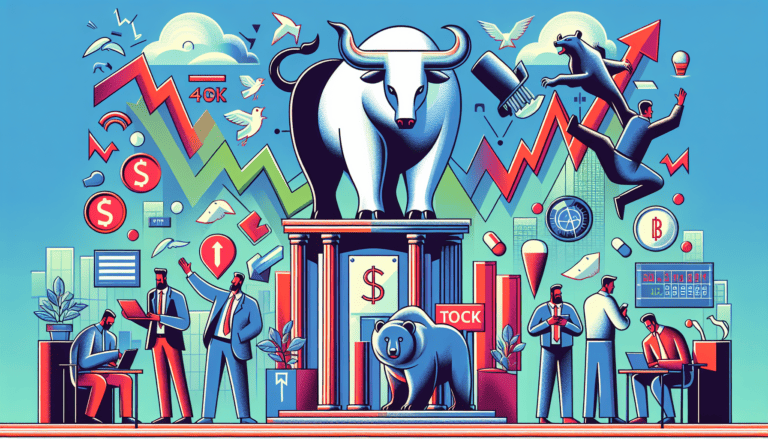The Psychology of Investing: Understanding Bull and Bear Markets Sentiment

Understanding Market Sentiment
Market sentiment is a critical element in the financial ecosystem, affecting every twist and turn within stock markets and exchanges. It represents the collective attitude, mood, and emotions of investors toward the market and can significantly impact the performance of stocks and indices.
The Role of Investor Attitude
Investor attitude is the driving force behind market sentiment. It is the culmination of individual perceptions, expectations, and reactions to various economic and financial signals. This collective mindset can powerfully sway the market, leading it to adopt a bullish or bearish trend. In bull markets, optimism prevails, and rising prices reflect increased investor confidence. Conversely, bear markets are characterized by pessimism, with falling prices mirroring decreased investor confidence. These phases are well-documented and crucial to understanding the dynamics of stock market trends and cycles.
Measuring Market Emotions
Quantifying the emotional state of the market is no simple task, yet several indicators have been established to capture the essence of market sentiment. These tools serve as the market’s pulse, providing valuable insights into the prevailing emotional state of investors.
-
Fear and Greed Index: This indicator assesses the level of fear and greed in the market, using data from stock price movements, trading volume, and options activity to compute its readings. It operates on the principle that excessive fear can result in stocks trading well below their intrinsic values, while extreme greed can inflate prices beyond what fundamentals would justify.
-
Investor Sentiment Surveys: Regular polling of investors and market analysts offers a snapshot of the collective mood. These surveys gauge the bullish or bearish outlooks of market participants, helping investors understand the prevailing sentiment.
-
The Volatility Index (VIX): Often referred to as the “fear gauge,” the VIX measures market risk and investors’ expectations of near-term volatility. A higher VIX indicates increased fear, whereas a lower VIX points to complacency or confidence in the market.
By examining these indicators, investors can gain a better grasp of market sentiment and its potential influence on investment decisions. The relationship between sentiment and stock prices is complex, and while these tools provide essential data, they must be used judiciously within the broader context of stock market analysis techniques. The emotional ebb and flow of the market is a key component of bull and bear markets: market sentiment, driving the decision-making process in the ever-evolving landscape of the investment world.
Key Indicators of Sentiment
Investor sentiment plays a pivotal role in financial markets, often influencing the direction of stock prices. Understanding this sentiment can be critical for investors, especially when distinguishing between bull and bear markets: market sentiment. Several tools and indicators can help gauge the mood of the market, providing insights into the collective emotions of investors.
Fear and Greed Index
The fear and greed index is a sentiment gauge designed to measure two of the primary emotions that influence how much investors are willing to pay for stocks. A high reading on the index suggests greed is prevailing, while a low reading indicates fear among investors. The index takes into account various factors, including stock price movements, trading volume, and options activity Time. It is a useful tool for investors to understand the extremes of market sentiment and can act as a contrarian signal; extreme fear can be seen as a buying opportunity, while extreme greed might signal a market top.
Investor Sentiment Surveys
Surveys such as the one conducted by the American Association of Individual Investors (AAII) provide a regular snapshot of the mood among market participants. These surveys measure the percentage of individual investors who are bullish, bearish, or neutral on the stock market’s direction over the next six months. The results can serve as a contrarian indicator; overwhelming bullishness may suggest caution, while strong bearish sentiment could signal a potential market bottom (Investopedia).
The Volatility Index
The CBOE Volatility Index (VIX), commonly referred to as the “fear gauge,” is another prominent sentiment indicator that measures the market’s expectation of near-term volatility conveyed by stock index option prices. A higher VIX value indicates increased fear or uncertainty in the market, while a lower VIX suggests confidence among investors. It’s worth noting, though, that the VIX should be used in conjunction with other indicators and not as the sole determinant in investment decision-making (Investopedia).
| Indicator | Description | Purpose |
|---|---|---|
| Fear and Greed Index | Assesses the emotions driving market activity | To identify potential extremes in market sentiment |
| Investor Sentiment Surveys | Gauges bullish or bearish sentiment among individual investors | To act as a contrarian signal for market trends |
| The Volatility Index (VIX) | Measures market expectation of near-term volatility | To understand the level of market fear or confidence |
Sentiment indicators are an essential component of stock market analysis techniques and can be particularly useful for timing the market. However, they are best used as part of a broader investment strategy. For more foundational knowledge about financial markets, delve into topics such as understanding stock exchanges and major global stock exchanges.
Bull Markets Explained
In the realm of investing, understanding the dynamics of bull markets is crucial for both novice and seasoned investors. These periods are critical to grasp as they can significantly influence investment decisions and portfolio growth.
Characteristics of Bull Markets
Bull markets are distinguished by a prevailing sense of optimism, growing stock prices, and heightened investor confidence. These markets are often reflective of a robust economy where investors anticipate continued growth and positive returns. Notably, bull markets don’t just signify brief upticks in stock prices; they are characterized by sustained increases over an extended period.
Key features of a bull market include:
- Rising prices: Stocks generally experience a sustained increase in value.
- High investor confidence: Optimism about market direction leads to more buying activity.
- Strong economy: Economic indicators such as low unemployment rates and rising GDP often accompany bull markets.
- Increased trading volumes: The optimistic outlook drives more transactions in the stock market.
During these times, understanding stock exchanges and stock market indices can help investors keep track of overall market performance. Bull markets often see indices like the S&P 500 and Dow Jones Industrial Average reaching new highs.
Impact of Optimism on Stocks
The palpable optimism during bull markets has a direct effect on stock prices. As investor confidence surges, more individuals are inclined to buy stocks, anticipating future gains. This increased demand propels stock prices upward, creating a self-reinforcing cycle of positive sentiment and rising valuations.
The impact of this optimism can be quantified by looking at key market indicators:
- Trading volume: Higher volumes indicate increased buying interest among investors.
- Stock valuations: Companies’ market capitalizations grow as stock prices rise (market capitalization and its importance).
- IPO activity: A bullish market often correlates with a surge in initial public offerings (IPOs), as firms capitalize on investors’ willingness to invest in new ventures.
The bull and bear markets: market sentiment not only influences individual stock prices but also affects entire sectors and can have global repercussions. For instance, during a bull market, sectors such as technology and consumer services may experience significant growth due to increased consumer spending and investment in innovation.
Investors looking to capitalize on a bull market may consider adopting specific stock market analysis techniques or exploring exchange-traded funds (ETFs) in stock markets to diversify their portfolios and mitigate risk. However, it is essential to remain vigilant about the potential risks and to have strategies in place for when the market sentiment shifts. Understanding the cyclical nature of stock market trends and cycles can help investors recognize when a bull market may be reaching its peak and a bear market could be on the horizon.
Bear Markets Uncovered
Bear markets are a critical concept in the world of finance, especially for beginner investors who are keen on understanding financial markets. Recognizing the traits and effects of a bear market can help investors navigate these challenging periods.
Traits of Bear Markets
Bear markets are typically marked by widespread pessimism, investor fear, and a general decline in stock market values, often persisting for an extended duration. These markets are characterized not just by falling prices but also by a significant reduction in investor confidence. This decline is usually measured from recent highs and is often triggered by a combination of economic downturns, geopolitical crises, or systemic financial system challenges.
According to Bankrate and Time, a bear market is officially recognized when there’s a 20% or more drop in stock prices from recent highs, sustained over at least a two-month period. Conditions typically associated with bear markets include:
- A decline in the stock market indices, reflecting falling prices across the board.
- Reduced trading volumes as investors retreat from the market.
- An increase in short selling, where investors bet on declining stock prices.
- Greater market volatility, often measured by indices such as the VIX (Volatility Index).
Effects of Pessimism on Prices
The permeating negativity in a bear market tends to exert downward pressure on stock prices. Investor sentiment during these times is heavily influenced by fear and pessimism, prompting a selloff that leads to decreasing stock values (Bankrate). The psychology behind this can be attributed to the loss aversion theory, where the pain of losing is more potent than the pleasure of gaining, causing investors to offload their holdings to avoid further losses.
Consequently, bear markets often see:
- A decrease in market capitalization due to the collective decline in stock prices.
- A slowdown in initial public offerings (IPOs) as companies await better market conditions.
- Potential delays in dividends or a reduction in dividend payouts as companies conserve cash.
- An uptick in market regulation and oversight to stabilize the market and protect investors.
Understanding the nature of bear markets is essential for investors, as it informs their approach to stock market analysis techniques and investment strategies during these periods. It’s also crucial to recognize that bear markets, while challenging, are a normal part of the stock market trends and cycles, and awareness of these patterns can aid investors in decision-making.
Influence of External Events
The mood of the stock market is not only shaped by internal dynamics but also by a range of external events. Economic data releases and geopolitical developments are two of the most potent forces that can sway market sentiment, turning the tide from bullish to bearish or vice versa.
Economic Data and Market Mood
Economic indicators play a pivotal role in shaping investor sentiment. Positive economic reports, such as strong employment numbers or robust GDP growth, tend to foster optimism among investors, buoying stocks and contributing to a bullish market sentiment. Conversely, disappointing economic data can fan the flames of fear, leading to a bearish outlook.
Investors keen on understanding stock exchanges should pay close attention to key economic indicators such as:
- Unemployment rates
- Consumer price index (CPI)
- Housing market stats
- Retail sales figures
- Manufacturing data
These indicators provide insights into the health of the economy, which in turn affects the performance of major global stock exchanges. For instance, a sudden spike in unemployment may trigger a sell-off, while an unexpected uptick in retail sales could fuel a rally in the markets.
Geopolitical Events and Investor Reaction
Geopolitical events are another critical factor influencing market sentiment. Issues ranging from trade agreements and tariffs to military conflicts and elections can have immediate and profound impacts on investor confidence and, by extension, on stock prices.
For example, the announcement of trade negotiations may lead to a surge in market optimism, while the outbreak of hostilities in a key economic region might plunge the market into a state of apprehension. Even rumors of political instability can cause investors to react, often resulting in increased market volatility.
Investors should stay informed about current events and understand their potential impact on the market. Resources like stock market analysis techniques and the mechanics of stock trading can provide valuable insights into how these external factors may play out in the financial markets.
In conclusion, while market sentiment is inherently tied to the collective mood of investors, it is also at the mercy of the broader economic and geopolitical landscape. By staying attuned to these external events, investors can better navigate the ebb and flow of bull and bear markets: market sentiment. Whether it’s keeping an eye on initial public offerings (IPOs) or monitoring stock market regulation and oversight, a comprehensive understanding of these influences is essential for making informed investment decisions.
Sentiment and Investment Strategies
Investor sentiment is a powerful force in financial markets, influencing stock prices and shaping investment strategies. Understanding how sentiment affects market behavior can provide investors with the tools to make more informed decisions. Below, we explore the contrarian investing approach and how sentiment tools can be used to time the market.
Contrarian Investing Approach
The contrarian investing approach is predicated on going against prevailing market sentiment. This strategy is based on the belief that widespread pessimism or optimism about stock prices can lead to market overreactions, creating opportunities for those who dare to go against the grain. For example, during a bear market, when fear and negativity are rampant, contrarian investors may identify buying opportunities, purchasing undervalued stocks that others are hastily selling. Conversely, during a bull market, they may look for signs of excessive optimism—an indicator that it may be time to sell or short-sell certain stocks due to overvaluation (Investopedia).
A contrarian approach requires meticulous research and a solid understanding of market fundamentals. It also demands a high tolerance for risk and patience to wait for the market to recognize the true value of mispriced stocks. For those interested in the mechanics of this strategy, further reading can be found on stock market analysis techniques.
Timing the Market with Sentiment Tools
Market timing with sentiment tools involves using various indicators to gauge the mood of the market and predict potential turning points. Some of the commonly used sentiment indicators include the Fear and Greed Index, the Investors Intelligence Sentiment Survey, and the CBOE Volatility Index (VIX), often referred to as the “fear gauge” (Investopedia).
| Sentiment Indicator | Description |
|---|---|
| Fear and Greed Index | Measures market sentiment based on factors like stock price movements and trading volume (Time) |
| Investors Intelligence Sentiment Survey | Gauges the mood of market newsletters |
| AAII Sentiment Survey | Tracks investor sentiment among individual investors |
| CBOE Volatility Index (VIX) | Estimates near-term market volatility based on options pricing |
These tools can signal whether investors are overly fearful or greedy at any given time. For instance, a high VIX suggests increased fear and potential market turbulence, while a low VIX indicates complacency and lower expected volatility. While sentiment indicators can be helpful, they should be used in conjunction with other forms of analysis and not as the sole basis for investment decisions (Investopedia).
Investors looking to incorporate sentiment indicators into their strategy might also consider the implications of stock market trends and cycles, short selling, and leverage and margin trading to better understand market dynamics.
In summary, sentiment plays a crucial role in investment strategy. Whether one adopts a contrarian approach or uses sentiment tools for market timing, a comprehensive understanding of sentiment’s impact on bull and bear markets can be instrumental in navigating the complexities of the stock market. Investors are encouraged to continue their education with resources such as understanding stock exchanges and the role of brokers and dealers for a more rounded comprehension of market operations.





